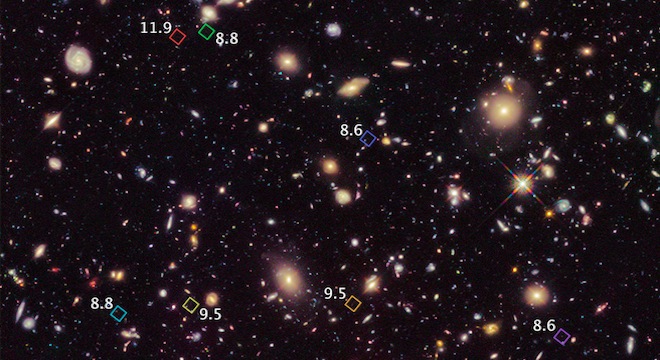Call them the “seven dwarfs.”
Using the Hubble Space Telescope, scientists in the U.S. and U.K. have discovered seven distant galaxies they believe to be among the furthest and most ancient yet spotted, NASA announced Wednesday.
The galaxies, which are thought to have formed about 13 billion years ago, between 350 million and 600 million years after the Big Bang, are located in the constellation Fornax, located in the Southern sky and visible to U.S. skywatchers during the winter months.
One of the galaxies is a likely candidate for the furthest and most ancient yet spotted, thought to have been formed just 380 million years after the Big Bang, the light from which has has traveled some 13 billion years to reach us, allowing Hubble to see the galaxy as it looked in its, and the universe’s, earliest days.
All seven galaxies were spotted during what researchers say is the “first reliable” cosmic census of this era of the Universe, which actually surveyed 20 different newly uncovered distant galaxies.
“We’re quite certain that these galaxies indeed lie on the outer reaches of our visible universe,” wrote Matt Schenker, an astronomy graduate student at Caltech and one of the researchers who participated in the discovery, in an email to TPM.
Here’s an annotated image from Hubble showing all seven galaxies highlighted in boxes, with numbers indicating their redshift values, indicating how far away they are. The higher the redshift, the further away. The furthest candidate is at redshift 11.9.

That redshift makes this candidate older than the recently announced candidate for the oldest galaxy also discovered using Hubble, but during a different survey, CLASH, that uses cosmic galaxy clusters to magnify distant galaxies.
The census was part of an effort called the Hubble Ultra Deep Field (HUDF or UDF), led by California Institute of Technology (Caltech) astronomer Richard Ellis and his colleagues at the institute.
The findings of the survey came from six-weeks of observations between August and September, and are just now being published in a new series of papers. Collectively, the discovery of these galaxies and their young age range, so close to the cosmic dawn, bolster the theory that the formation of galaxies could have reheated the Universe hundreds of millions of years after the Big Bang itself.
“Because these galaxies are all quite faint, and only visible in a few of the filters we use for imaging (by design), it’s difficult to undertake a detailed comparison between them,” Schenker explained. “At the very least, we can say that they are all quite compact, much smaller than our own.”
Specifically, the scientific team used four colored filters on Hubble to spot light from the ancient galaxies that had traveled so far and so long through the universe it had been redshifted, or stretched out, as the universe has expanded and the galaxies have moved away from each other.
“The four color filters are all in the near-infrared, so longer wavelength light than the human eye can see alone,” Schenker said.
The survey was only possible thanks to a Hubble instrument installed just three years ago in 2009, the the Wide Field Camera 3. Scientists nine years ago undertook another HUDF survey, but it was more limited without the new camera, as Schenker explained.
“Because of the expansion of the universe, the light from more distant galaxies is shifted to longer wavelengths, all seven of these galaxies are only visible in near infrared light, which Hubble has only become sensitive to with the installation of the Wide Field Camera 3 in 2009,” Schenker wrote.
Still, the survey from nine years ago proved to helpful with obtaining the newer findings.
“We do use the old HUDF data, though, to check that we do not observe any light in the optical filters from our candidates, which is expected if they truly lie at these distances,” Schenker added.
NASA isn’t just releasing the new images and findings though: The agency is on Friday at 1 p.m. EST holding a live Q&A on Google Plus to provide more information to the interested public. Check it out here.






